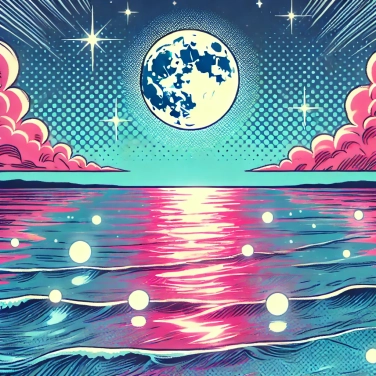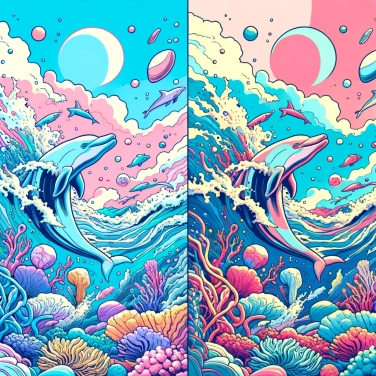Moonlight rays can sometimes cause phosphorescence in the water because they can stimulate bioluminescent marine organisms like plankton, which emit light under specific conditions to defend themselves or attract prey.

The moonlight, although in truth a simple reflection of the sun, is sometimes enough to trigger phosphorescence in certain microscopic marine organisms, most often bioluminescent plankton. These organisms possess special molecules called luciferin and luciferase that, when they react together after light stimulation, produce a faint blue-green glow visible in the twilight of night. Essentially, under the moonlight, these tiny beings capture even the slightest amounts of light, and their internal biochemistry is activated, triggering a gentle aquatic illumination sometimes observable to the naked eye. The result? Water that appears magical, illuminated by small living glimmers solely due to the subtle presence of moon rays.
Aquatic phosphorescence mainly comes from chemical reactions within small marine organisms, usually bioluminescent plankton. These creatures contain a substance called luciferin, which reacts with an enzyme, luciferase. Under the influence of an external stimulus—such as that from moonlight, even faint—the organisms are disturbed, triggering the internal chemical reaction. This reaction then produces soft, bluish visible light, very distinct in the night darkness. These tiny luminous reactions are actually a form of defense against predators, sometimes inadvertently attracting curious onlookers fascinated by this light display.
Marine phosphorescence under the light of the moon is mainly observed when certain climatic and environmental conditions are met. Calm water, without too many powerful waves, is particularly necessary as it facilitates the gathering and stability of small luminous marine organisms called bioluminescent plankton. Warm water that is relatively low in nutrients also promotes their proliferation, especially during the summer months. The less light pollution (city lights, boats, etc.) there is, the more spectacular the effect will be, allowing these tiny creatures to shine even brighter under the gentle moonlight. Particularly clear and transparent water enhances the phenomenon, allowing the faint reflections of the moon to reach the plankton more effectively.
Scientists have repeatedly observed and documented seas that shine with a brilliant blue-green under the moon. One of the most well-known instances occurred in the Maldives, where millions of tiny bioluminescent organisms (called dinoflagellates) illuminated an entire shore. The same phenomenon has been observed in the San Diego area, where the beaches sometimes offer a stunning light display when the water is stirred or simply by the movement of a wave. Such episodes have even garnered a nickname from some specialists, referring to these phosphorescent seas as "milk seas" due to their pale and uniform glow. Satellite images have allowed for the identification and study of these luminous phenomena, sometimes revealing extensive areas covering hundreds of square kilometers. These nighttime observations have facilitated the understanding of what prompts these organisms to light up the water in response to slight external stimulation, such as the softness of moonlight or the gentle movements of the nighttime water.
The moonlight has no direct chemical power to make the water itself shine. In reality, it acts more as an indirect trigger, influencing the behavior of certain organisms that are capable of producing their own light.
Under certain ideal conditions (absence of light pollution, calm weather, and a high concentration of luminescent organisms), it is possible to observe luminous trails left by dolphins or boats moving through the water at night.
The popular legend of the 'seas of milk', where the entire ocean appears to shimmer with a thousand lights, is linked to real phenomena that were observed and scientifically documented as early as the 19th century. This impressive phenomenon results from a significant proliferation of luminescent organisms.
Aquatic phosphorescence, often referred to as marine bioluminescence, is generally produced through a molecule called luciferin, which emits light when it reacts with oxygen in the presence of a special enzyme (luciferase).
Sure! Here’s the translation: "Yes, the best way is to choose a full moon night with a clear sky, and then head to certain beaches or lagoons known for their high concentration of bioluminescent organisms. You can also try to slightly provoke this reaction by gently stirring the water at the surface."
The phenomenon is much rarer in freshwater, as bioluminescent organisms are seldom found there. However, certain specific species of bacteria or microalgae present in freshwater can exceptionally cause a slight luminescence that is observable under certain specific circumstances.
Yes, the intensity of light reflected by the moon does indeed depend on its phases. Thus, during the full moon, increased brightness can significantly influence the behavior of bioluminescent organisms, making luminous emission phenomena more noticeable.
Phosphorescence refers to the property of absorbing and then slowly re-emitting light after excitation, while bioluminescence is the production of light by living organisms through a specific chemical reaction, without the need for prior absorption. In most cases observed under the moon, it is rather bioluminescence that is at play.
Not directly, as the moon only reflects sunlight without emitting any radiation that would directly cause luminescence. However, moonlight can indirectly influence aquatic organisms by altering their behavior and chemical reactions.
No, only waters that contain a high concentration of luminescent organisms, such as certain plankton or bioluminescent algae, can exhibit this phenomenon. These organisms release light when mechanically stimulated or under certain environmental conditions.

0% of respondents passed this quiz completely!
Question 1/5